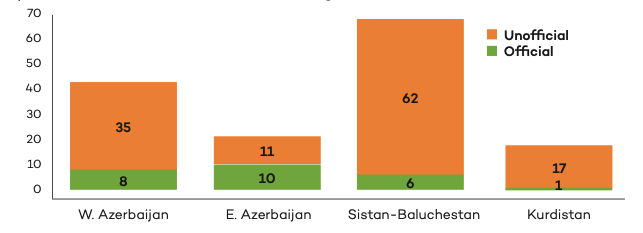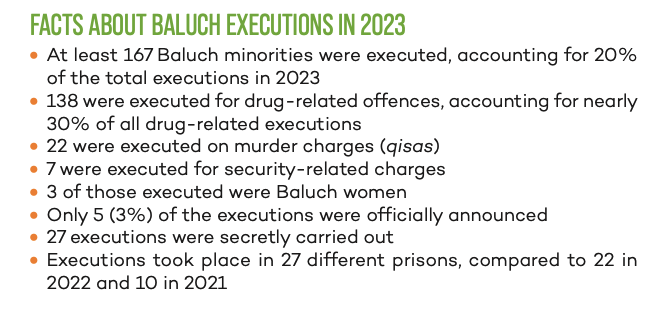iranhr.net – This is an extract from the 2023 Annual Report on the Death Penalty in Iran. To read the full report, please click here.
ETHNIC MINORITIES
As this report and previous annual reports demonstrate, ethnic minorities in Iran are overrepresented in death penalty statistics. Furthermore, with 25 executions per million inhabitants, Sistan and Baluchistan province had the second highest number of executions per capita in 2023. According to the present report, 150 people were executed in the 4 ethnic provinces of West Azerbaijan, East Azerbaijan, Sistan and Baluchistan, and Kurdistan in 2023. This number was 130 in 2022, 62 in 2021 and 60 in 2020.
Because the execution of ethnic minorities are not implemented exclusively in their home provinces, it is difficult to specify the exact number of each ethnic minority groups’ execution. Furthermore, information about those executed does not always include their ethnicity. The execution of Baluch prisoners are in many cases carried out in prisons outside the Baluchistan region.

In 2023, more than 84% of the executions recorded by Iran Human Rights in East and West Azerbaijan, Kurdistan and Sistan and Baluchistan were not announced by the authorities.
Furthermore, the absolute majority of those executed for their political affiliation belong to ethnic groups, the Kurds in particular. An overview of Iran Human Rights reports between 2010-2023 shows that at least 154 people were executed for affiliation to banned political and armed groups. Of those, 76 (49%) were Kurdish, 45 (29%) were Baluch and 24 (16%) were Arab, with a majority of them being Sunni Muslims.
There are several possible reasons for the overrepresentation of ethnic groups in execution figures. One explanation might be that the authorities use more violence to create fear due to higher opposition amongst the population in those regions. During the nationwide protests following Jina (Mahsa) Amini’s state killing, Kurdish regions and Baluchistan were the areas with the longest-lasting protests, and almost half of all protesters killed on the streets were from Baluchistan, Kurdistan and other Kurdish towns in other provinces. The authorities targeted propaganda labelling its critics in the ethnic regions as separatists, as well as the presence of armed groups in those regions makes it easier for authorities to justify death sentences under the pretext of fighting terrorism and separatism. All this has led to less domestic and international sensitivity to the execution of people from ethnic regions, and thus, a lower political cost for the atrocities. Finally, with these regions already suffering from poor socio-economic conditions, local judicial offices also act more lawlessly and arbitrarily in the four ethnic provinces.
Execution of Baluch minorities
With 68 executions, Sistan and Baluchistan province had the second highest number of total executions, and with 25 executions per million inhabitants, it was the province with the second-highest number of executions per capita in 2023. There are no official figures for the population of Baluch minorities in Iran, but different sources estimate the number to be between 1.5[1] and 4.8 million[2], accounting for 2-6% of Iran’s total population. However, research and monitoring by Iran Human Rights shows that in 2023, at least 167 Baluch prisoners were executed, accounting for 20% of all recorded executions in Iran. 110 of the 167 executions took place in prisons outside Sistan and Baluchistan province. The gross overrepresentation of Baluch people in the execution figures in Iran has elicited reactions from rights groups and the international community.[3]

[1] https://iranprimer.usip.org/blog/2013/sep/03/iran-minorities-2-ethnic-diversity
[2] https://unpo.org/members/7922
[3] UN Experts Alarmed Over Execution of Baluch Minority Prisoners: https://news.un.org/en/story/2021/02/1083772
 Shabtabnews In this dark night, I have lost my way – Arise from a corner, oh you the star of guidance.
Shabtabnews In this dark night, I have lost my way – Arise from a corner, oh you the star of guidance.



